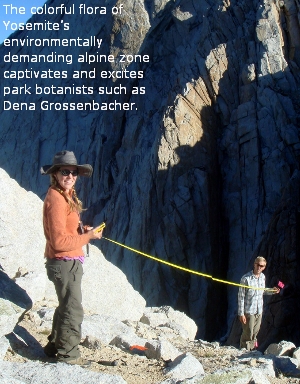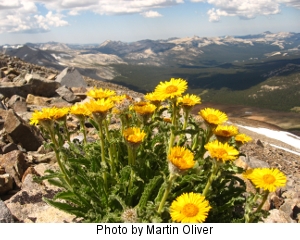The alpine zone at the crest of the Sierra Nevada is the highest-elevation ecosystem in California. Yosemite National Park has a large number of relatively flat, cold, windswept, unglaciated alpine summits that are possibly the oldest habitats in the region, having escaped the scouring action of glaciers by virtue of their great height.
Because of their age and environmental extremes, these plateaus may harbor some of the rarest and most specialized plants in the park.Dena Grossenbacher, a Ph.D. candidate at the University of California, Davis, in the Department of Evolution and Ecology, explores and researches this lofty realm as a botanist for the National Park Service, studying the evolutionary and ecological processes that cause adaptation and species formation in California plants.
Grossenbacher will highlight her work in a slide presentation, “Alpine Plant Diversity on Yosemite’s Sky Islands,” at the Yosemite Area Audubon Society’s (YAAS) monthly program Thursday, Dec. 13, at 7 p.m. at the Mariposa Methodist Church parish hall on 6th Street in downtown Mariposa.
The program will examine the somewhat bizarre natural history of this distinctive flora.
 With a special interest in monkeyflowers, Grossenbacher says, “I’m particularly interested in how interactions between species drive the evolution of these unusual-looking flowers.
With a special interest in monkeyflowers, Grossenbacher says, “I’m particularly interested in how interactions between species drive the evolution of these unusual-looking flowers.
“I fell in love with the flora of the Sierra Nevada when I moved to California 10 years ago, and I’ve worked as a seasonal botanist in Yosemite National Park conducting inventories of rare plants and habitats ever since.”
Like all YAAS programs, Grossenbacher’s presentation is open and free to the public, although donations to defray program costs and to support Audubon’s local activities are welcome. Refreshments will be available.
The YAAS also encourages local residents to participate in any of several local and nearby Christmas bird counts, part of the National Audubon Society’s 113th international bird census, in December and early January. A separate article elsewhere on this website provides details of these counts, including dates, meeting times and locations.
Each count is an all-day affair, but participation for only part of the day can be arranged. Participants at all levels of birding experience are needed and should bring binoculars, field guides, lunch, snacks and beverages. Dress warmly in layers, wear comfortable walking shoes or boots, and bring wet-weather gear.
The mission of the National Audubon Society, the namesake of noted 19th-century naturalist and bird painter John James Audubon, along with its state affiliate, Audubon Californiam, and local chapters such as the Yosemite Area Audubon Society, is to conserve and restore natural ecosystems, focusing on birds, other wildlife and their habitats for the benefit of humanity and the earth’s biological diversity.
Call (209) 742-5579 or (209) 966-2547, or visit www.yosemiteaudubon.org for additional information about either the program or the Christmas bird counts.




